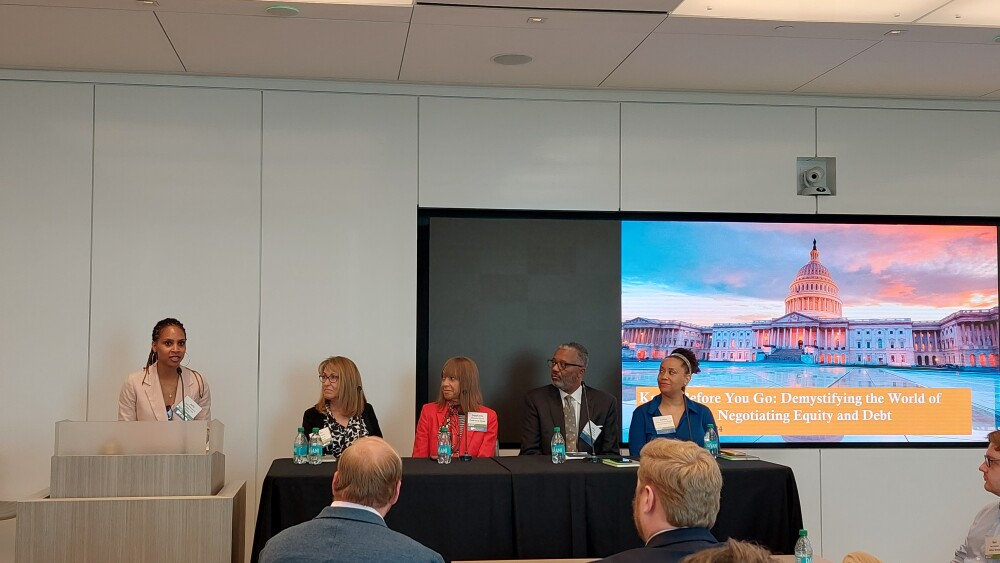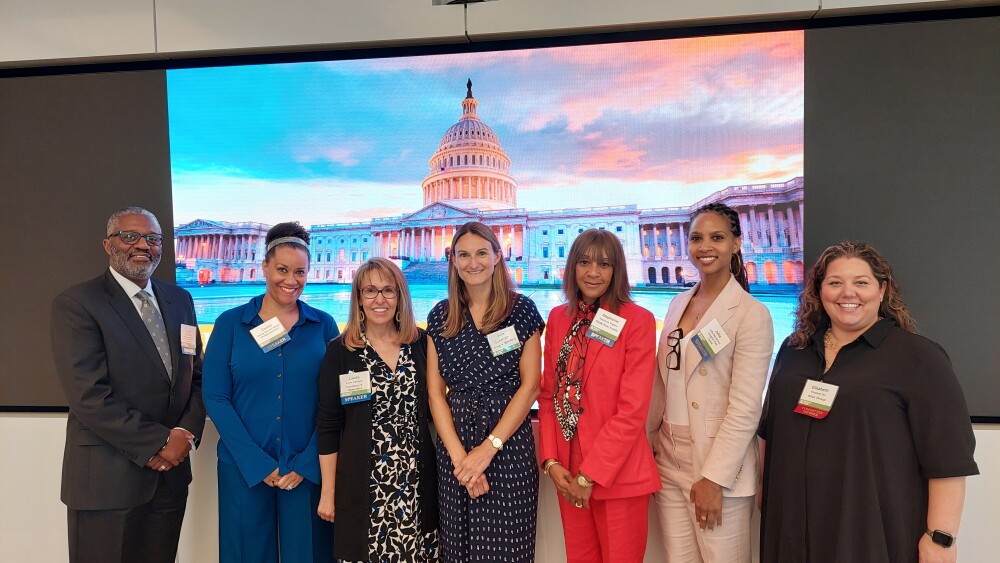
Moderator Julia Stevenson, head of acquisitions at Langdon Park Capital; Lynda Gallagher, a senior managing director and regional manager in the Washington, D.C. office of Cushman & Wakefield Valuation & Advisory; Stephanie Wiggins, managing director/head of production, agency lending, for PGIM Real Estate; Larry Hentz, executive director of business development of Prince George’s County Economic Development Corporation; and Carisa Stanley Beatty, first vice president of Amalgamated Bank.
ULI Washington/Heather Hrycyshyn
On Thursday, CREW DC, AAREP DC, and ULI Washington delivered the third and final program in a series intended to demystify valuations and provide practical insights on negotiating equity and debt. Held at the offices King & Spalding at 1700 Pennsylvania Avenue, Julia Stevenson, head of acquisitions at Langdon Park Capital, served as moderator.
“We can say that there’s perceived or actual or subconscious/unconscious/implicit [bias],” Stevenson said in recapping the first panel. “The fact is, if you don’t understand the appraisal process, it will be hard to navigate negotiating capital [when] speaking with your lender, or even [when] questioning challenging appraised value.
“[The second program] talked about the dearth of research . . . and data available to . . . dissect whether there’s truly bias or whether it’s just a perception, whether it’s lack of knowledge … to navigate the real estate process, et cetera,” Stevenson noted.
The third program sought to illuminate how and why values matter in the realm of capital markets.
Linda Gallagher, a senior managing director and regional manager in the Washington, D.C. office of Cushman & Wakefield Valuation & Advisory, filled the role of appraiser on the panel. “Typically, when an appraisal comes in, especially for financing, or there’s equity debt, value is already penciled out. It’s the appraiser [who] doesn’t know it. And part of the due diligence is often the underwriting, the pro forma . . . the various information that allows you to understand the deal, and oftentimes that’s not provided until after the appraisal is sent. And then it’s disappointing because it doesn’t meet certain criteria.”
“The valuation is such a key component of the deal, and the appraiser is often the one that’s in the dark,” she added, noting that commercial real estate tends to be unemotional investment, so it should be a very open and transparent process. She expressed frustration in noting that, at times, she receives an underwriting package and there’s “a delta, and that means either I’m wrong or they’re wrong.
“Your appraisal is an unbiased, supported opinion of value. And so, the support is what you will see in the appraisal report and the analysis, and it tends to be backwards-looking, because we use sales. When a market is changing dramatically, like it has been over the past couple of years, past information is outdated and irrelevant.”
Looking ahead
Appraisers spend time looking toward the future to understand land-use trends and what’s happening in the market, Gallagher explained. “There’s a huge spotlight on this profession [because] there are not enough of us, and therefore, the more information that can be provided from the borrower side, from the bank side . . . obviously it’s on the appraiser to know what’s happening in the market, what’s happening around the property.”
Stephanie Wiggins, managing director/head of production, agency lending, for PGIM Real Estate, said, “There’s a regulatory wall between us as the lender and you [Gallagher] as the appraiser. For me, I am completely hands off [regarding] the engagement of the appraiser and even [in] seeing the report until it’s done, or at least in a draft form.” The PGIM Real Estate agency platform includes Fannie Mae, Freddie Mac, FHA, and some of PGIM’s proprietary capital comes from its parent company, Prudential Financial.
Once she has the report, however, Wiggins says, “That’s actually where my advocacy for my deal starts.” She advocates for her clients by combing the appraisal and looking at comps for missed data.
Wiggins stressed that sponsors can help their lenders sell the deal to the lenders’ investment committees, noting the onus to know your market falls on the lender and the developer. “As a developer, you want to know the high points of your deal. You want to be able to sell it to your lender, and then the lender needs to sell it internally,” she said. “We work together to get that deal done and to get you across the finish line. . . . That’s the hidden dirty secret of lending . . . that it’s not all cut and dry. Relationship is absolutely king in any market. And particularly in a down market. You get a lot more when you have a relationship with your lending partner in a down market.”
Telling the story
Picking up the theme of knowing your market, Stevenson asked Larry Hentz, executive direct of business development for Prince George’s County Economic Development Corporation, to talk about investments in the county, such as the FBI headquarters and its hundred-year economic impact.
Hentz noted that Prince George’s County is 500 square miles (1,295 sq km), with just shy of a million people, 40 percent of whom hold a college degree. The average annual household income there is $90,000.
“It ranks among the top 4 percent of counties in the United States, making it 125 out of 3,124,” Hentz added. “But the reality is also that, even though we’re in the top 4 percent, the top 1 percent are the counties surrounding us—Fairfax, Alexandria, Montgomery, Loudoun.”
A decision was made in 1943 to break ground for the Pentagon. “I don’t believe [that anyone] foresaw the billions and billions of dollars that resulted from that decision and . . . made Northern Virginia what it is today.”
Today, the FBI Headquarters, slated to break ground in 2025, is expected to bring 7,500 jobs to the county, as well as all the contractors associated with the FBI and $100 million for infrastructure improvements from the state of Maryland, according to Hentz. It will be an anchor that, over time, will attract new companies to Prince George’s. They include ones in sectors that are critical to the FBI’s mission, such as technology and cybersecurity companies.

Larry Hentz, executive director of business development of Prince George’s County Economic Development Corporation; Carisa Stanley Beatty, first vice president of Amalgamated Bank; Julia Schmidt, real estate partner at King & Spalding; Stephanie Wiggins, managing director/head of production, agency lending, for PGIM Real Estate; Julia Stevenson, head of acquisitions at Langdon Park Capital; and Elizabeth Pye, business development manager at Altus Group.
ULI Washington
The dance
Carisa Stanley Beatty, first vice president of 140-years-old Amalgamated Bank, said, of the process, “It is a dance.”
For example, a lot of negative news is coming out of Chicago, Beatty noted, such as crime and underwater deals. “But [Amalgamated’s] general account right now is not bullish on Chicago. And so, unfortunately, you could bring the most perfect deal into investment committee for, let’s say, our core-plus fund, and the minute they say ‘Chicago’ on the cover page, they’re done. They’re just done. I mean, that’s bias.”
The bias is not coming from the appraiser or the owner/operator or the developer, Beatty says. As a lender, she goes to the investment committee with lots of data, including the appraisal and market information, to “mitigate this bias that our own people have around markets and asset classes right now.
“When you’re dealing with big institutions, it’s about getting them to do the dance between all of the [bits of] information [where their bias exists], what they’re experiencing in the now” and balancing that with forward-looking information about a market coming from, for example, an economic development authority to help “sell the vision.”
“The first hurdle that I always have to overcome is [explaining to the credit committee/investment committee] what this market is in a way that they understand,” Beatty says. As a New York bank, speaking to that committee about D.C. neighborhoods in a way they’ll understand might mean equating D.C. neighborhoods with New York neighborhoods that the committee knows.
The other type of bias could stem from the type of deal, she said. For example, Amalgamated didn’t do a lot subsidized housing, because the bank didn’t have the experience with that deal type. “Now, I have changed that [stance], because I came to the bank with a subsidized housing background,” Beatty added.
Appraisal bias
In terms of the bias of the appraiser, Gallagher pointed out that she doesn’t benefit from the appraisal, apart from the fee, which is not tied to value. “I think the bias pops up in commercial real estate when you have a certain level [of] professional—a professional [who] does institutional quality, or a tends to be not understanding of the property type, or not understanding [of] a market. And that’s on the appraiser to learn it.”
“There’s a lot of value out there,” Gallagher said. “But if you don’t dig deeper and understand the dynamics of that investment, you’re going to miss it. You’re going to miss it because you’re a city girl, or you’re from the suburbs, and you’re just seeing a very heavy industrial use and not understanding the supply and demand.”
Pizza magic
Julia Stevenson and Elizabeth Pye, business development manager at Altus Group. developed the idea for the series over pizza. Stevenson suggested that the duo come up with a program which would provide a better understanding of the world of appraisals and valuations, and look at it though a lens of equity.
Given the dearth of women appraisers and minorities, the friends were curious about how the lack of representation would affect the appraisal process.
“Residential information is publicly available, whereas [commercial real estate is privately owned, and so there is] very little evidence available to aggregate and draw conclusions,” Stevenson noted as one big takeaway from the series. Another was that bias in appraisals takes place for different reasons, particularly because of lack of market information and understanding.
“I’m proud that Julia and I could have been a part of bringing these conversations to light,” Pye said. “This is just one seed of something that needs to . . . grow and become a bigger conversation and a more prominent conversation.”







